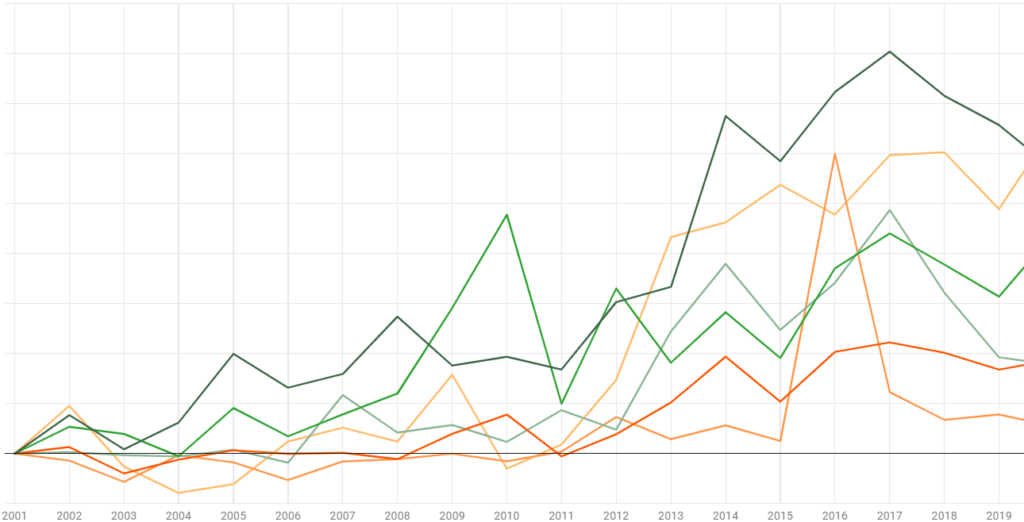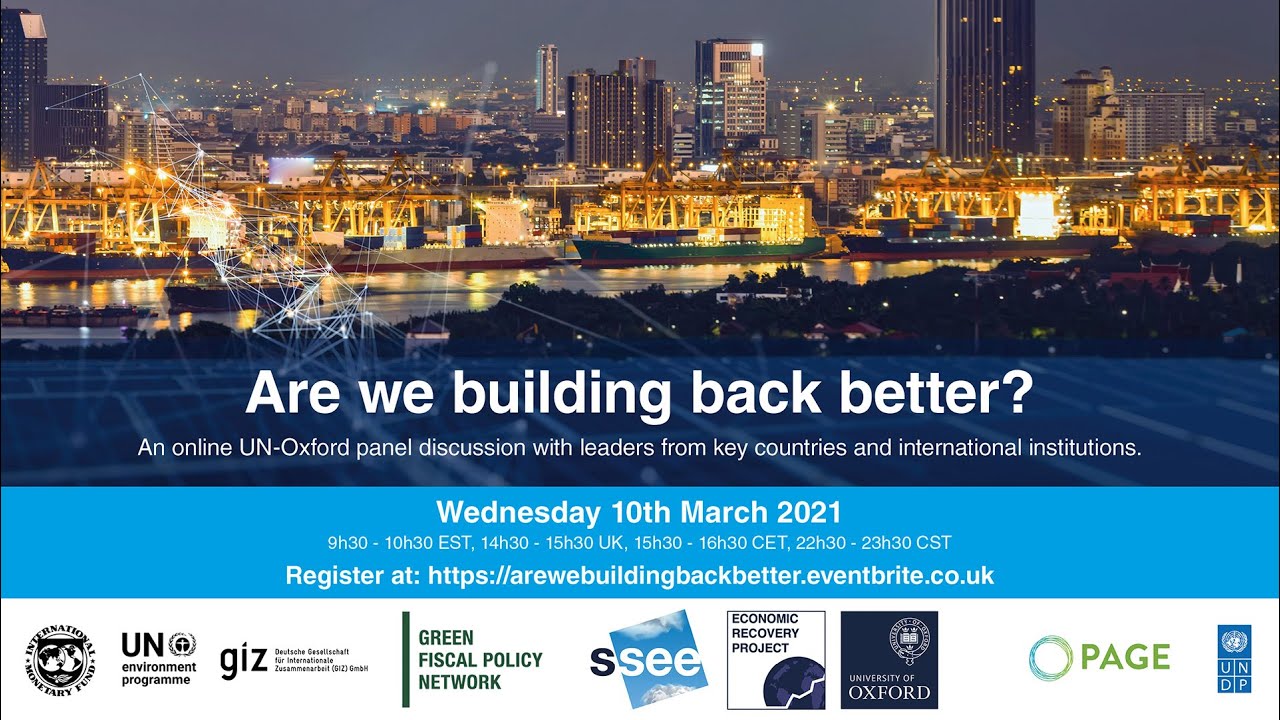Global Recovery Observatory
The Global Recovery Observatory brings transparency to global government spending during the COVID-19 crisis. The intent of the Observatory is to showcase exemplary policy solutions, identify lost opportunities and direct governments towards more impactful and sustainable fiscal spending.
The Global Recovery Observatory tracks and assesses every individual COVID-19 related fiscal spending policy announced by the 50 leading economies (more countries to be added) for potential impacts on the environment and the socio-economy. The Observatory database is updated weekly. This data visualisation is developed by UNDP and utilises the Observatory data. It also draws inspiration from a report led by the Oxford University Economic Recovery Project and the UN Environment Programme (UNEP), Are We Building Back Better? Evidence from 2020 and Pathways for Inclusive Green Recovery Spending.
How to use the Observatory
The first view will give you a global snapshot of the 50 leading economies’ green recovery spending. By clicking on a country bubble, you will be able to see the breakdown of all recovery efforts by policy archetypes. Click on the policy and drill down to find out more about each policy and it’s relative ‘greenness’ based on potential impact on long- and short-term Green House Gas emissions, air pollution, natural capital, quality of life, inequality and rural livelihood. Data is focusing on ‘recovery’ spending as opposed to ‘rescue’ spending.
Methodological Note: The information contained in the visualisations is updated in real time and reflects the most recently available data and exchange rates. The numbers presented here may differ from those published in the accompanying analytical paper ‘Are We Building Back Better’ – which only covers data tracked to December 31, 2020. Deviations are driven by fluctuations in exchange rates and the public release of new data from official government sources in 2021, related to announcements in 2020.
Methodology Update: A planned methodology update for the Global Recovery Observatory on the 21st of August 2021 has updated the Observatory’s currency conversion approach from a live model to a static model. Local currency values are now converted to USD using the exchange rate on the day of the policy announcement, rather than using live exchange rates updated everyday.
*The current database will inevitably include errors; such is the nature of manually recording nearly 4,000 policies and 32,000 data points (as of March 2021). The Oxford team relies on users to help improve Observatory accuracy and coverage. Please direct any correction requests here.
Background Documents

FULL REPORT: Are we Building Back Better?
COVID-19 has led to a global crisis threatening the lives and livelihoods of the most vulnerable by increasing poverty, exacerbating inequalities, and damaging long-term economic growth prospects. The report, Are We Building Back Better? Evidence from 2020 and Pathways for Inclusive Green Recovery Spending, provides an analysis of over 3500 fiscal policies announced by leading economies in 2020, and calls for governments to invest more sustainably and tackle inequalities as they stimulate growth in the wake of the devastation wrought by the pandemic.

SUMMARY for Policymakers: Are we Building Back Better?
Spotlight on Green Recovery
News

Green recovery: Spur small business climate action for stable economies, says international small business leader
In a world that is dominated increasingly by the effects of climate change, small businesses need more support than ever to keep economies running and citizens happy and healthy. Small businesses, governments and industry leaders alike can work together to build a resilient ecosystem by raising awareness, emphasizing proactivity over reactivity and cultivating accountability.
Blogs

Using Machine Learning to Make Government Spending Greener
A groundbreaking pilot project undertaken by UNEP and UNCTAD shows how machine learning models can predict the environmental impacts of development spending. This data-driven approach can guide scarce public finance flows with sustainability and national development goals in mind.
Reports

Monitoring the Climate Impact of Fiscal Policy – Lessons from Tracking the COVID-19 Response (IMF)
This paper takes stock of the contributions made by these various trackers, identifies strengths and weaknesses of their methodologies, and draws lessons for assessing the climate impact of fiscal policy going forward. It finds that: trackers provided useful assessments of the (generally low) level of greenness and raised awareness; trackers’ methodologies, while valid and innovative, varied significantly with some important, if currently largely unavoidable, weaknesses; and the way forward should involve tracking the greenness of entire government budgets, rather than just their response to the COVID-19 crisis.
Policy Briefs

Are We Building Back Better – COP26 Update
Building Back Better Update – COP26: Governments are not reorienting their economies to a green future and vulnerable nations are being left behind Although COP26 has been anticipated as an

By loading the video, you agree to YouTube's privacy policy.
Learn more
FAQ
The Global Recovery Observatory (the Observatory) is a joint initiative between the University of Oxford and the Green Fiscal Policy Network (the UNEP, IMF, and GIZ) to track and analyse global economic spending policy. The data visualisation of the Observatory is developed by UNDP and utilises the Observatory data.
The Observatory is housed within the Oxford University Economic Recovery Project (OUERP) at the Smith School of Enterprise and the Environment. Observatory data visualisations are presented on the OUERP website, the GFPN website, and UNDP’s COVID-19 Data Futures Platform.
The Observatory aims to provide transparency to government spending practices. We envisage that it will act as a tool for governments and researchers to assess spending, and that these assessments will be used as an input in their future stimulus decision making. The Observatory intends not only to support COVID-19 fiscal policy and spending, but to provide a rich database for informing research and response for future economic crises. The Observatory is also a tool to increase transparency for tracking government progress against long-term economic, environmental, and social objectives, as well as alignment with the 2030 Agenda for Sustainable Development and the UNFCCC Paris Agreement.
The project began in March 2020 as input to the seminal paper Will COVID-19 fiscal recovery packages accelerate or retard progress on climate change? (Hepburn et al, 2020). The Observatory was previously managed as the Oxford Tracker of Recessionary Fiscal Stimulus and used as a tool to help governments around the world orient their spending to initiatives that prioritise economic, social, and environmental prosperity.
The Observatory tracks and assesses rescue and recovery fiscal policies of the 50 largest economies globally (plus the EU). As of February 2021, the Observatory has around 3,500 policy items in its database. Policies are sorted by country and date, and sources are provided. Additionally, the Observatory assigns each policy to an exhaustive and mutually exclusive taxonomy of 40 archetypes and 158 sub-archetypes, including spending and some taxation measures. Based on archetype, policies are assessed on a variety of economic, environmental, and social impact characteristics, providing indications of potential impacts on major global crises including climate change, nature loss, pollution, and inequality.
A policy archetype method is used to assess policy items for:
- potential environmental impact (greenhouse gas emissions, air pollution, natural capital),
- Potential social impact (wealth inequality, quality of life, rural livelihood), and
- Potential economic impact (multiplier, speed of implementation).
These assessments consider the impact of policy against a scenario in which no intervention is made. All archetype impact assessments are a work in progress. We invite any peer reviewed literature that suggests that current assessments could be adapted. Please submit recommendations here.
The Observatory assess a green spending policy as one that is likely to reduce GHG emissions, reduce air pollution, and/or strengthen natural capital, compared to a scenario in which the policy is not implemented.
Archetypes and sub-archetypes are assessed for environmental impacts (short-term and long-term GHG emissions, air pollution and natural capital) and some other socio-economic ones, based on evidence in academic literature, contributions by a 2020 survey of over 230 leading practitioners in fiscal economics (Hepburn et al., 2020), and an ongoing discussion with leading economists and scientists.
The Observatory assessments are not predictions and do not aim to quantify policy impacts. A methodology document including a full list of archetypes, sub-archetypes, and assessments is available in an accompanying methodology working document (O’Callaghan et al., 2020).
The Observatory is a dataset of country responses to the pandemic. The objective is not to rank countries – but to provide transparency to both global and national actions and assess progress towards commitments to building back better.
Advanced economies (AEs) and emerging market and developing economies (EMDEs) are both included in analyses. But this is done to provide a global picture of recovery spending. The different capacities and challenges faced by AEs and EMDEs in recovery spending choices and resourcing are acknowledged. This classification is only helpful for adding a very simple layer of disaggregation to global analysis, as both the AE and EMDE groups are not homogenous internally.
The Observatory focuses on recovery, rather than pandemic relief, spending because progress towards ’building back better’ can be better assessed by focusing on government policy recovery packages. Once short-term and immediate relief has been provided, policymakers have an opportunity to design recovery and stimulus measures which align national socio-economic trajectories with Agenda 2030 and Paris Agreement objectives.
Several other groups are also tracking and evaluating fiscal spending in response to the COVID-19 crisis, with varying aims and methodologies. None of these trackers cover global spending in quite the same depth or breadth as the Observatory – the Observatory covers the top 50 largest economies, as well as the European Union, and analyses potential policy impacts across environmental, social, and economic perspectives. The Observatory tracks at a significantly higher granularity than all other trackers we have seen, enabling more accurate and informed policy categorisation and impact assessment. Unlike trackers from some multilateral sources, the Observatory relies purely on publicly available data sources to provide complete transparency. Further comparisons are available in O’Callaghan and Murdock (2021) and UNEP (2020).
The Observatory is currently undergoing expansion to include all PAGE countries outside of the biggest 50 economies and all countries in the Latin America and Caribbean region.
Thank you for your conscientious use of the dataset. We rely on your detail-oriented review to ensure reliability and credibility of the Observatory.
Please use this form to request a correction. All data is based on publicly available sources and correction requests must be accompanied by such sources to be accepted. Note that only fiscal policies ostensibly introduced or accelerated due to COVID-19 are included.
We apologise for any inconvenience caused. Please provide details of your issue using this form.
Please consult the following links from UNEP, Oxford SSEE and GFPN:
Yes. Subscribe to the Oxford Economic Recovery Project newsletter for regular updates on the Global Recovery Observatory. You can also subscribe to the newsletter of the Oxford SSEE and/or Green Fiscal Policy Network for other related news.
Contact
If you would like to know more about the Global Recovery Observatory take a look at our FAQ.
You can also subscribe to the newsletter of the Oxford SSEE and/or Green Fiscal Policy Network for regular updates on the Global Recovery Observatory.
You can also contact us at contact@greenfiscalpolicy.org.









